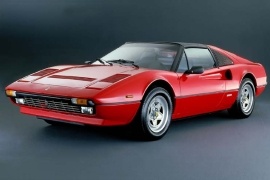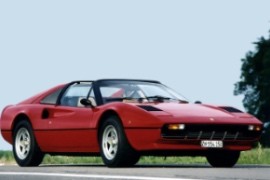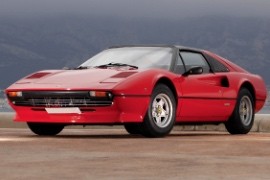FERRARI 308 GTB/GTS Models/Series Timeline, Specifications & Photos
First production year: 1975
Engines: Gasoline
Body style: Coupé (two-door)
At the beginning of the ‘80s, Ferrari was forced to detune the engines installed in the 308 lineup to comply with stricter regulations, but the Italian automaker gained back its lost ponies when it introduced the 1982 Quatrovalvole powerplant.
The 308 was already a seven years old vehicle, but it was still appealing to Ferrari’s customers. Its beautiful lines were penned by the famous Leonardo Fioravanti during his years at Pininfarina studio. The Prancing Horse brand offered the car either as a coupe or as a convertible, and both were very fashionable at their times. Furthermore, the car’s performance was difficult to match by most of its competitors since it was light and well-proportioned. The mid-engine solution proved to be the key to success, and there were just a handful of automakers to do that. In addition, since the car was driven by Tom Selleck in the Magnum P.I. series, it became an instant hit in the U.S. As a result, customers had high expectations from Ferrari to bring back the performance lost due to emission regulations. Since the automaker had already implemented a fuel injection system developed by Bosch, it only had to adapt it to a new set of cylinder heads fitted with dual overhead camshafts and four valves per cylinder, hence the name Quattrovalvole (four valves in Italian).
When the automaker revealed the 308 GTSi Quattrovalvole at the 1982 Paris Motor Show, besides the upgraded engine, it also showed the styling changes made to the car. At the front, the car sported a slightly different fascia, which included a set of rectangular fog lamps mounted under the blinkers/parking lights. The broad slatted grille where the Ferrari badge took center stage was similar, while below it, a small spoiler improved the vehicle’s aerodynamics.
Ferrari didn’t want to change things that didn’t need to be updated, so the 1982 308 GTSi Quattrovalvole featured the same removable top. The car manufacturer considered that the targa solution worked better for the vehicle instead of creating the car as a classic convertible. Behind the safety arches that connected the broad and triangular B-posts, the automaker installed a vertical window in front of the engine bay, which sported a new lid to allow the increased size of the cylinder heads. On the rear fascia, there were a couple of discreet changes. The four taillights featured reversing lights on the outer lamps, and there were four exhausts instead of two, like in the previous version.
With a cabin fit for two, the 308 GTSi Quattrovalvole boasted a high level of comfort and luxury despite being a supercar. It featured high bolstered seats with leather upholstery, separated by a tall center console that housed the gear stick, the handbrake, and an armrest. In addition, there were a few buttons and levers that controlled the ventilation and the windows, while a stereo found its way into the center stack above the vents.
Behind the cabin, Ferrari installed a redeveloped 2.9-liter V8 that was mounted in a transverse position. Thanks to the new cylinder heads featuring 16 valves each, the car manufacturer gained 25 ponies at 6,800 rpm, 200 more revs than on the two valves per cylinder version offered by the previous, 1980 model year.
Due to stricter emission regulations, Ferrari had to cut the power of its engines in the late ‘70s, but later, it gained back some of the ponies lost thanks to the four-valve technology.
When Ferrari wanted to replace the Dino, it employed Leonardo Fioravanti from Pininfarina to pen it. Moreover, the Italian automaker used fiberglass-reinforced plastic (GFRP) body panels to make the vehicle lighter. To top it all off, it also added a transversely mounted V8 engine behind the cabin to make it one of the fastest vehicles available. However, when it had to reduce the car’s emissions, in 1980, Ferrari switched from the carbureted to a Bosch K-Jetronic fuel-injection system, and the result was a loss of about 55 PS (54 hp). In 1982, the Prancing Horse brand introduced the four-valve technology into the 308 lineup, resulting in the Quattrovalvole version of the coupe and the targa, respectively. While the GTB didn’t benefit from the huge advertisement gained via the Magnum P.I. series in the U.S., it was still a sought-after vehicle, albeit its sales were far from those obtained by its GTS sibling.
Ferrari unveiled the 308 GTB Quattrovalvole at the 1982 Paris Motor Show. Besides the upgraded engine, it also added a few tweaks to the car’s look. At the front, the automaker added a set of rectangular fog lamps integrated under the bumper into the broad lower grille. For specific markets, the same combo that included the turn signals and the parking lights was kept. Another improvement was noticed on the lower side of the apron, where Ferrari changed the lip spoiler’s look.
From its profile, the car got new metric-sized wheels, while the 16-inch alloys were still available as an option. Both shared the same five-spoke design, with a yellow center cap sporting the Prancing Horse badge. The tiny lever that opened the doors was concealed on the door’s rear pillar above the rounded-shaped air intake that fed the engine behind it. Finally, at the back, the Italian automaker introduced new taillights that sported the reversing lights on the outer lamps instead of the inner ones, as on the previous models.
Inside, the 308 GTBi Quattrovalvole kept the same two-seat layout but with a slightly different design for the center console between them. There, the automaker placed the gear stick, the handbrake, and a few extra buttons for the ventilation system and the power windows. There was no AC, but a stereo became available. However, the automaker installed comfortable, leather-covered bolstered seats, which helped their occupants stay in place during high-speed cornering maneuvers. Fronting the driver was the same five-dial instrument cluster, with larger ones for the speedometer and tachometer and smaller gauges for the fuel level, coolant temperature, and ammeter. On the center console, Ferrari placed an oil-pressure gauge and a clock.
Behind the cabin, Ferrari installed a redeveloped 2.9-liter V8 that was mounted in a transverse position. Thanks to the new cylinder heads featuring 16 valves each, the car manufacturer gained 25 ponies at 6,800 rpm, 200 more revs than on the two valves per cylinder version offered by the previous, 1980 model year.
The 308 was available as a coupe, the GTB, and as a targa: the GTS. In 1980, due to emission regulations, the car manufacturer had to find solutions to keep the power levels up and still comply with the rules. To do that, it installed a Bosch Motronic fuel injection system into both versions of the car, hence the “i” letter behind the GTB and the GTS, respectively. But the sales were still at a modest level. Then, the Magnum P.I. happened. The American TV series started in late 1980. It starred Tom Selleck in the leading role, a private investigator who drove a 308 GTSi in the movie, and suddenly, the car became instantly recognizable on the streets. So, despite the weaker engine, sales went through the roof. Nevertheless, it is worth mentioning that it wasn’t a slow vehicle by those times’ standards. Its low weight and punchy V8 transversely mounted behind the cabin pushed the 308 GTSi quicker than most other sports cars available on the market.
But Ferrari didn’t bother to change the car’s exterior, which was penned by Leonardo Fioravanti while working for the Pininfarina design studio. The 1980 Ferrari 308 GTSi featured a pair of pop-up headlights and a set of vents behind them on the upper side of the fenders. Below the automaker placed a horizontal rubber stripe that served as a bumper and was flanked by the lamps for the turn signals and the parking lights.
From its profile, the aerodynamic vehicle boasted a raked windshield with slim A-pillars. The removable roof could be stored behind the seats, while the broad B-posts were triangular and extended towards the car’s back. The automaker placed a vertical rear window behind the cabin and in front of the engine’s lid. At the same time, the round air intakes that flanked the bodywork were placed on the waistline, just above the rear quarter panels, creating an iconic image for the 308 lineup. Finally, at the back, Ferrari installed twin round taillights, where the reversing lights were integrated into those mounted inwards.
The leather-wrapped interior of the 308 GTSi featured a pair of bucket seats with bolstered areas to provide enough side support for their occupants. Fronting the driver was a clean-looking instrument cluster with two large dials for the speedometer and tachometer and three additional gauges for fuel level, oil pressure, and coolant temperature. In addition, on the center console, the automaker added a couple of extra gauges for the ammeter and an analog clock.
Under the hood, Ferrari placed the same 2.9-liter V8 found in the previous version of the car, albeit improved by a fuel injection system. That allowed the Italian car manufacturer to provide customers with a 244 PS (240 hp) engine. It paired it with a five-speed manual transmission that sent all the oomph to the rear wheels.
When Ferrari introduced the 308 GTB in 1975, there was little concern about emission standards and pollution, but that was changed by 1980, forcing the Italian automaker to slash the power to generate fewer emissions.
Back in the ‘80s, when the fastest American road-going vehicle was the Dodge li'l Red Express, Ferrari had to struggle to pass the emission tests with a car that wasn’t created to do that. So, the Italian car manufacturer went on to the German parts manufacturer Bosch and installed a K-Jetronic fuel injection system in the 308. However, the U.S. version was fitted with a catalytic converter, which lowered emissions but also affected the power. As a result, the 1980 GTBi could barely pass the 200 hp mark, which wasn’t seen as a high-performance vehicle. Fortunately, despite not using the glass-fibber reinforced plastic (GFRP) body panels, the 308 Gran Turismo Berlinetta didn’t weigh too much, so it could still be enjoyable, especially on a winding road.
The automaker did little things to the car’s exterior to differentiate it from its predecessor. As a result, the retractable headlights were still there, fitting in the supercar arena trend. Behind them, the automaker placed a set of vents on each side above the fenders. The rubber stripe that crossed the vehicle’s front fascia from side to side was flanked by the lamps that incorporated the parking lights and the blinkers. The U.S. version got a fatter bumper due to the 5 mph (8 kph) rule, while the European model was slimmer.
With a design signed by Leonardo Fioravanti, the 308 GTB was an eye-catching go-fast coupe. Its low-slung stance, short nose, and sculptured side intakes placed behind the doors were unique features on the market. For the 1980 model year, Ferrari installed new, metric-type light alloy wheels. As an option, though, customers could still get the 16-inch alloy wheels sporting a five-spoke shape. Out back, the 1980 Ferrari 308 GTBi boasted its four-taillight design, which was also carried over from its predecessor. A quad-exhaust system and the chromed badge of the vehicle confirmed the car’s status as a go-fast GT vehicle, even though it was mostly a personal luxury supercar.
The cabin was changed significantly from its predecessor. It featured leather-trimmed seats and offered a luxurious ambiance despite being a sparse cockpit. There was no AC or other modern amenities for those times. At least it featured power windows, helping the driver get more fresh air when needed. Along with this update, the automaker introduced the oil thermometer and the clock on the center console, in front of the handbrake and the gear stick. The latter was moved inside a gated metallic piece.
Under the hood, Ferrari placed the same 2.9-liter V8 found in the previous version of the car, albeit improved by a fuel injection system. That allowed the Italian car manufacturer to provide customers with a 214 PS (211 hp) engine. However, the U.S. version only offered 205 PS (202 hp).
The targa version of the Ferrari 308 GTB received the GTS name and it was one of the cars that made the Italian brand notorious in the U.S. thanks to a movie-series.
You didn't have to grow a mustache and be a detective to drive a Ferrari GTS, but for those who dreamed about themselves to be some kind of heroes just because their bank account showed a six-figure number, it was the right car. Just two years after the GTB was unveiled at the Paris Motor Show, the car received a targa version.
The 308 GTS was one of the best-known Ferrari on the market, and its shape became legendary. The narrow front end with pop-up headlights, the raked windshield, and the side air-intakes made the car unique. Pininfarina designed its shape, and he did, as usual, a great job. From its sides, the thick B-pillars served as side panels and roll-over protection. The Italian designer kept the round taillights as a legacy for the prancing horse brand in the back.
Inside, the carmaker tried to offer a luxurious yet sporty interior. The sport-bucket seats sported leather upholstery and used the same material to cover the door panels. Its black plastic dashboard featured three round air-vents. A removable stereo was offered as an option.
Under the hood, the 308 GTS featured a 2.9-liter V-8 engine that offered 255 hp for the European market and 240 hp for the U.S. market.
Ferrari unveiled the 308 GTB sports car at the Paris Motor Show in 1975, and it was a complete departure from the car’s predecessor, the Dino 246 GTB.
The Italian automaker made the sports car based on some underpinnings from the Dino. Moreover, the vehicle’s design was made by Leonardo Fioravanti at Pininfarina, the same man who penned the 246 GTB. Still, several significant improvements made the 308 GTB a successful go-fast vehicle in Europe and the U.S. Later on, its open-top sibling, the 308 GTS, went on TV shows and gained immense popularity among those who could afford to buy one. The car’s advantages were not limited to its glass-reinforced plastic (GRP) bodywork but also to its interiors and, most importantly, to the powerful engine.
Using a GRP bodywork made the car lighter and, therefore, faster. But the automaker also insisted on making the 308 GTB as aerodynamic as possible but still capable of getting two people onboard easily and transporting them in comfort. At the front, the car featured pop-up headlights with a set of vents behind them that helped cool some radiators. The front bumper sported a black rubber stripe that also housed the turn signals and the parking lights and a grille for the main radiator underneath it.
From its profile, the car showed its graceful look with a low nose and a raked, panoramic windshield. Its short roof was continued at the back by sloped down pillars. Fioravanti penned the vehicle with a set of side air intakes that were sculptured on the door panels and emerged onto the rear quarter panels. This made the car unique not just on the market but also in Ferrari’s history book. Finally, the back of the car looked impressive with its four round taillights and the single exhaust on the side underneath the bumper.
The cabin was comfortable enough for two people, and Ferrari tried its best to create a luxurious environment for its customers. Ferrari covered most areas with leather, including the door cards and the dashboard. In front of the driver, the automaker placed a rectangular-shaped instrument cluster that showed other relevant information about the car’s status besides the speedometer and tachometer. Between the leather-covered sports seats, the car featured a narrow center console with a few switches and buttons for the power windows.
Certainly, the most attractive part of the car was found under its “Vetroresina” (fiberglass) bodywork. The engine mounted in the back was a 2.9-liter V8. It was a clear evolution over the Dino 245 GTB, which featured a 2.0-liter V6. The 308 GTB offered 255 PS (252 hp) for the European version, while U.S. customers got a 240 hp (243 PS) unit due to emission restrictions. Both versions were fed by twin-choke Weber carburetors and sent their power to the rear wheels via a five-speed manual gearbox.





